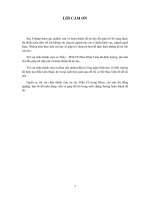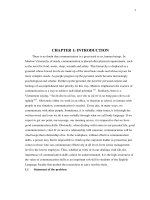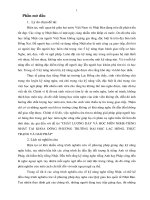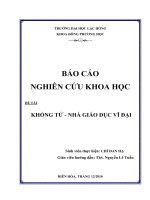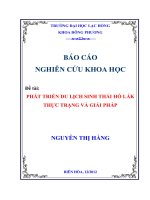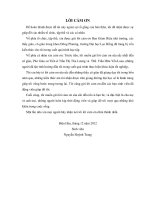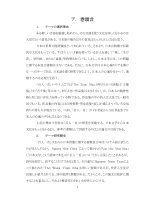Báo cáo nghiên cứu khoa học " TRISTEZA DISEASE AND ITS MANAGEMENT " pdf
Bạn đang xem bản rút gọn của tài liệu. Xem và tải ngay bản đầy đủ của tài liệu tại đây (2.3 MB, 35 trang )
TRISTEZA DISEASE AND ITS
MANAGEMENT
NGUYEN VAN HOA
SOUTHERN FRUIT RES. INST.
What is virus?
What is virus?
It is only the DNA or RNA fragment, it may be single or
double strains with the coat protein.
DNA or RNA may be free from coat protein and self
replication using the genetic material from the host (virus
infected tree).
It can move from one cell to another through plasmodemata
and become systemic infection through phloem tissues and the
whole tree got infection.
Potential virus diseases on fruit crops
and its management
Introduction
Tristeza virus was considered original from China.
Tristeza was called as quick decline in America, is the
most destructive disease and spread through out the
world.
Only 2 decades after tristeza was introduced from Africa
to South America in 1920s, the disease caused much
damaged to citrus industry in Argentina, Brazil and
Uruguay. Especially on sweet orange grafted on sour
orange. Virus normally does not express the symptoms
on the resistant combination between rootstock and scion
of mandarin and Trifoliata orange.
Symptoms of CTV on different citrus
species/clone
Citrus tristeza virus (CTV) caused many
different symptoms based on the virus
isolates, Citrus variety and the combination
of rootstock and scion.
In Asia, many isolates/strains such as
seedling yellows (CTV-SY), tristeza (CTV-T),
stem pitting - (CTV-SP), and one mild strain.
Any strain can get infection on one tree or
infected by many strains at the same time.
Quick decline, or tristeza disease
The following varieties got infection with quick decline if
it was grafted on sour orange, pumelo or rough
lemon: Sweet orange, mandarine (including
Satsuma and Ponkan group), Tankan, Iyo, Tangor,
varieties belonging to tangelo, and grapefruit. The
tree got infection and shown yellowing and wilt and
then die within years. If it is grafted on resistant
rootstock such as Trifoliate or mandarin, it will be
recovered soon.
Symptoms
Seedling yellows
Young seedlings of sour orange, Natsudaidai, rough lemon infected with
CTV-SY strain, the canopy become yellow and die. If it is grafted in
the resistant rootstock it will be recovered quickly.
Stem pitting disease
All most the citrus cultivars infect with the stem pitting strain, even when
it was grafted on resistant rootstock. Grapefruit, tangelo, tangor,
sweet orange, Iyo, Yuzu and natsudaidai are very sensitive to the
disease, even the Satsuma and Ponkan are resistance.
The susceptible variety infect show stem pitting on trunk, branches,
twigs. Infected tree become dwaft, poor development and sometime
even died. Lead the trees have more flowers but fruit setting less,
fruit becomes small, deform. Some varieties show brown spots on
fruit or fruit with brown spots and gum oozing.
Symptoms
Citrus tristeza virus (CTV) is the causal agent of
quick decline on citrus grafted on sour orange.
At first, the infected tree bear small leaves, death of
young and small twigs, bearing small fruits.
In some cases, the infected tree got fast wilting and
death within weeks.
CTV caused incompatibility between rootstock and
scion leading to the girdling around the trunk base
with the yellowing symptoms.
These trees shown stem pitting on the xylem tissues
when the bark removed.
Vein clearing due to CTV
Tristeza disease on citrus
Virus particle under microscopy
Quick decline due to CTV infection
Stem pitting symptoms on the xylem tissues of citrus
Symptoms (cont.)
Symptoms (cont.)
Sweet orange cv.
Valencia grafted on
sour orange
rootstock affected
by Citrus tristeza
closterovirus (CTV).
Mexican lime seedlings
(Citrus aurantiifolia).
Left: healthy; right:
inoculated with CTV.
Dieback of sweet
orange grafted
on sour orange
caused by CTV.
Symptoms (cont.)
Symptoms (cont.)
Inverse pitting, honey
combing, or pinholing
induced by CTV below
the bud union on sweet
orange trees grafted on
sour orange rootstock.
Stem pitting induced by
CTV on small
branches of grapefruit
grafted on the
tristeza-tolerant rootstock
Citrus limonia.
Stem pitting
induced by
CTV
on a grapefruit
trunk.
Left: grapefruit from a healthy
tree; right:
four grapefruits from a tree
grafted on sour orange and
infected with CTV.
Vein clearing induced by CTV in
inoculated Mexican lime (C.
aurantiifolia) seedlings
incubated in a glasshouse at 18-25°C.
Symptoms (cont.)
Symptoms (cont.)
Symptoms of stem pitting on xylem
tissue and yellowing on fruit
Causal organism
Causal organism is a virus with filamentous
rod shape, length of 2,000 nm and 15 nm
width.
Virons stay in the phloem tissues of the host
and interfere the nutrition and water uptake
in the tree system.
The optimum temperature for virus infection
and multiplication is 20°C - 25°C.
Causal organism: Closterovirus
Virions have a simple construction and consist of a capsid. Virions are not
enveloped. Capsid is elongated and exhibits helical symmetry. The capsid
is filamentous, flexuous with a length of 2000 nm and width of 12 nm.
CTV strains
Citrus tristeza virus has many strains cause different
levels of damage.
Mild strain spread fast through aphid and infected
planting material. These strain do not cause quick
decline of sweet orange grafted on sour orange.
Quick decline strain occur and cause much damage.
When it is grafted on sour orange causing dwaft of
the tree. However, when it was grafted on resistant
rootstock, but showing symptomless event when it
gotinfection.
Symptoms due to deferent CTV strains
In some countries, CTV strain can cause
stem pitting on any kinds of rootstock.
The stem pitting showing on the xylem
tissues of trunk, branches and twigs. Looking
from outside, the branches become twisting
and bristle. The tree become less growth,
yield, bear small fruits.
Detection
Normally, all the strains can be detect
through indicators tree as Mexicane lime.
ELISA can be use with the polyantisera. One
monoantibody named MCA-13, can be used
for ELISA, and detect all the strain except
mild strain.
Beed ELISA showing enzyme
mediated colour reaction.
Microplate showing Double antibody sandwich-Indirect ELISA
results of enzyme mediated reaction of healthy and CTV infected
samples.
B and G rows - Buffer control C and E rows - Healthy sample
D and F rows - Infected sample A and H – Empty wells
I
I
H
H
Screening of citrus isolates against CTV by DIBA
From Top No.1 to 14 – Glass house mantained Puna isolates
1
st
row - CTV +Ve No. 15 to 28 - Glass house mantained Bangalore isolates
2
nd
row – Healthy No. 29 to 42 - Glass house mantained New Delhi isolates
No. 54- Healthy No. 43 to 47 - Glass house mantained viroid infected plants
No. 55-56 - CTV +Ve No.48 to53 – Field isolates
Electron microscopy showing Decoration of
CTV particles by homologous antiserum
Disease transmission
Disease transmission
Virus
Virus
Tristeza
Tristeza
is transmissible through
is transmissible through
aphid in a semi
aphid in a semi
-
-
persistent manner. Aphid
persistent manner. Aphid
can acquire the virus within minutes when
can acquire the virus within minutes when
it feed on infected tree and then transmit
it feed on infected tree and then transmit
the virus to the healthy tree within a
the virus to the healthy tree within a
minutes when it feed on the healthy one.
minutes when it feed on the healthy one.
Aphid lose their ability of transmission
Aphid lose their ability of transmission
within 24
within 24
-
-
48 hrs after leaf the infected
48 hrs after leaf the infected
tree.
tree.
Toxoptera
Toxoptera
citricida
citricida
is the most
is the most
effective aphid in transmission.
effective aphid in transmission.
Aphis
Aphis
gossypii
gossypii
of litchi or
of litchi or
cucubitae
cucubitae
,
,
Aphis
Aphis
spiraecola
spiraecola
and
and
Toxoptera
Toxoptera
aurantii
aurantii
are also
are also
transmissible aphids.
transmissible aphids.
Myzus persicae
– vector
transmit
Tristeza virus
(mild strain)
Aphis citricola –
Còng lµ t¸c nh©n
truyÒn bÖnh
Tristeza
